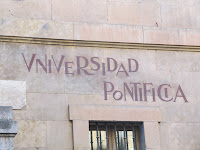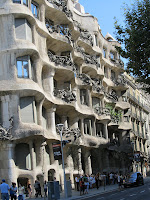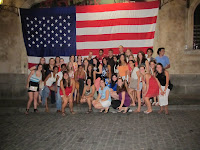In
The Buried Mirror , Carlos Fuentes traces the development of Hispanic culture from its diverse roots in Spain to its arrival and syncretism in the New World. While explaining the history of the Hispanic race, Fuentes describes elements of the culture like the Indian sense of the sacred, the baroque of the New World, and its struggle for democracy. As eloquent as Fuentes is, all of his ideas would have remained lofty stereotypes, were it not for an encounter I had with one such person who personified all these characteristics.
In the fall of 2006 I began working as a dean of discipline at an English immersion boarding school in Rhode Island. Working with another culture was frustrating and complicated, but one student in particular remained a complete enigma. She was Azuani Gutierrez from Veracruz, Mexico, and to me, she symbolized everything I misunderstood and did not appreciate about the Hispanic culture. I puzzled over Azuani’s cultural foibles until I began to read Fuentes’
The Buried Mirror. While reading Fuentes, it was like a veil was drawn back from my Anglo-American pretensions and I was able to understand Azuani in terms of her Hispanic culture. I wish that I had read Fuentes before working at this school, as I believe his insights would have bridged my cultural misconceptions. Nevertheless, understanding in retrospect is better than not understanding at all.
First and most frustrating of all among Azuani’s cultural habits, was her Spanish stoicism in regards to learning the English language. Unlike her fellow international students, Azuani arrived at the school without knowing a bit of English. At times she was determined to learn the language and at others she would simply give up.
One such day, I reminded Azuani to speak in English and she told me “No”. Her answer surprised me because usually Azuani was a very well behaved and obedient student.
“Excuse
me?” I said.
“Miss, I am who I am and I am not an English speaker.”
Perhaps Azuani’s attitude stemmed from momentary frustration at learning a new language, but her defeatist response puzzled me. In the United States the mindset is you are who you make yourself to be, but Azuani was content to be who she had always been. Her response mirrored that of some of the other students – a fatalistic, roll-with-the-punches attitude that believed some things could not be changed, but tiptoed around. Their attitudes reflected Seneca’s stoicism that Fuentes mentions early on in
The Buried Mirror as a reliance and trust in fate and blind acceptance of your lot in life.
I also became familiar with her culture’s sense of the sacred and commonality. Upon arriving to the school, Azuani began unpacking. I realized that she was taking longer than the others and I watched her from the doorway. She slowly and carefully removed several newspaper wrapped items from her carryon and set them on her bed. She unrolled the newspapers, revealing two small statues of Jesus and Mary, a picture of her family, two candles, and a lace doily. She then proceeded to set up a sort of shrine on her window sill and light candles. Horrified, not only by this blatant betrayal of the fire code, but also at her bedside altar, I intervened and asked Azuani the purpose for her domestic pyre. She looked pleadingly at her roommate and muttered something in Spanish.
“It’s an altar, Miss,” her roommate translated.
“I realize that, but the only altar around here is the one in the chapel, and she’s not lighting candles right under the smoke detector.”
Azuani nodded her head and sadly put everything away.
“It’s very pretty, Azuani,” her roommate commented. Azuani struggled for words for a second.
“Thank you,” she stuttered. “Whenever you want.”
I was to learn later that “Whenever you want,” was one of the students’ favorite phrases. Whenever you complemented Azuani or any of the students on their clothes, possessions, hairtstlyes, etc. they would always respond with, “Whenever you want.” I thought such a phrase was a minor colloquialism, but after reading Fuentes I saw the element of commonality in that phrase. Whatever one girl had was shared with the other and their individual closets melded into one giant walk-in, as the students borrowed each other's clothes constantly. I learned later that the students were allowed to have these “shrines” in their room, sans the candles, as it was a common practice in Mexico and elsewhere. These personal altars remained a mystical symbol that, to me, contrasted greatly with the school’s Roman Catholic practices. Fuentes explains that the altars were a practice of the indigenous Hispanic Americans, much like the altars for the dead. The blending of Jesus and Mary in a pagan style shrine, illustrated not only the Indian sense of the sacred but also the syncretism of indigenous and New World culture. Azuani’s generosity with her possessions exemplified the commonality of the Indian culture.
Azuani embodied the baroque of the New World in her very appearance with her Spanish blonde hair and her Indian brown skin and eyes. She sang indigenous New World songs with the lisp of Spain. In one moment she would be performing Spanish flamenco, and the next, setting up Indian altars throughout her room. Neither a morena nor a güerita, Azuani was mestizo, the perfect blending of the Spanish and Indian culture, the long lost descendant of Cortes and La Malinche.
By observing Azuani’s treatment of authority, I saw the battle for a dignified democracy in her culture. Although she was always friendly towards everyone, I would often see Azuani struggling to remain civil with her professors or glaring at the police officers in a park. I wondered about her aversions until the topic came up in a conversation. It was the spring of 2007 and while playing basketball, Azuani broke her ankle. I rushed her to the hospital in the school’s minivan and sat with her in the ER for six hours, attempting to translate her symptoms from Spanglish to English. Her foot casted and raised in the back seat, we began the drive home. I stopped for a red light in an empty intersection and Azuani leaned forward.
“Miss, just go,” she said sleepily.
“It’s a red light, Azuani,” I pointed out.
“Ay, you Americans,” she said. “You always have to follow the rules, even when no one’s watching.”
“For the most part,” I shrugged.
“In my country,” she said, “if you stop for a light, you will get robbed and car jacked. And if you get pulled over by a police officer for running it, you pay him 200 pesos and he lets you go.”
I thought about this for a moment and quickly wrote it off as another culture barrier between me and this enigmatic Hispanic. But, while I was reading Fuentes, it dawned on me that perhaps this is the reason for Hispanic America’s failed democratic attempts. Perhaps, the Spanish stoicism caused citizens to believe that democracy or dictatorship is fated, something that you shrug your shoulders at, rather than something you work for or against. And the many failed attempts at democracy and the resulting criminal activity caused a lack of trust in the Hispanic peoples. Perhaps Azuani mistrusted and disrespected authority because she had never had any authorities who lived up to their role. Her attitude represented a vicious circle of corruption and mistrust that does not allow for a democratic system of government.
In studying another culture, one tries to avoid generalizations or stereotypes. But, sometimes, those generalizations lend themselves not to understanding a culture as a whole, but to understanding better just one person within that culture. This is the case with my perception of Azuani Gutierrez. While in Rhode Island, Azuani remained a blurry picture that I recognized but did not understand. Like a Goya painting, Azuani was frightening in her foreign behavior and exotic habits. After reading Fuentes, Azuani remains a culturally diverse painting, but now I can see the brush strokes that went into her creation and understand the beauty of the culture that makes her who she is. Fuentes names his book
The Buried Mirror because he says that by looking in the mythic buried mirror, or by studying their history, Hispanics realize who they are. Likewise, holding the mirror to Azuani, I realized who she is and understood more about the culture from whence she came.
I have never been to Spain, nor have I had many dealings with the people of Spain. However, my experience with Mexicans runs deep and it is the hint of the Spanish blood that has caught my attention. A glimpse of the Spanish blonde, the tap of the Spanish flamenco, and the flash of the Spanish pride that at times seep through the Mexican persona have lured me to Salamanca. By tracing the Spanish influence to its roots this summer, I hope to better understand not only the Spanish people, but also the peoples who have been influenced by them.
 My time in Spain has come to an end with all the bittersweet feelings that are sure to accompany such a conclusion. A nervous excitement has taken hold of many summer program students in Salamanca. They pack the shops trying to find their last souvenirs and hold study halls in the cafés, attempting to cram in endless conjugations and corresponding verbs before finals.
My time in Spain has come to an end with all the bittersweet feelings that are sure to accompany such a conclusion. A nervous excitement has taken hold of many summer program students in Salamanca. They pack the shops trying to find their last souvenirs and hold study halls in the cafés, attempting to cram in endless conjugations and corresponding verbs before finals. in anticipation of fall. They sit by the Rio Tormes with a book in their hand and bare feet in the grass. They breathe it all in and know that they have not only discovered another culture, but a new part of themselves in that culture. It seems that we, the consummate tourists, have discovered Fuentes’ Buried Mirror as well.
in anticipation of fall. They sit by the Rio Tormes with a book in their hand and bare feet in the grass. They breathe it all in and know that they have not only discovered another culture, but a new part of themselves in that culture. It seems that we, the consummate tourists, have discovered Fuentes’ Buried Mirror as well.
 e that the Spain we have come to know will be forever frozen in the way we remember it, in the history we relate. Narcissistic in the extreme, this thought is quickly banished as we see the changing leaves and entering novitiates who will no doubt add to the country’s rich history.
e that the Spain we have come to know will be forever frozen in the way we remember it, in the history we relate. Narcissistic in the extreme, this thought is quickly banished as we see the changing leaves and entering novitiates who will no doubt add to the country’s rich history.  e that the Spain we have come to know will be forever frozen in the way we remember it, in the history we relate. Narcissistic in the extreme, this thought is quickly banished as we see the changing leaves and entering novitiates who will no doubt add to the country’s rich history.
e that the Spain we have come to know will be forever frozen in the way we remember it, in the history we relate. Narcissistic in the extreme, this thought is quickly banished as we see the changing leaves and entering novitiates who will no doubt add to the country’s rich history. 











































